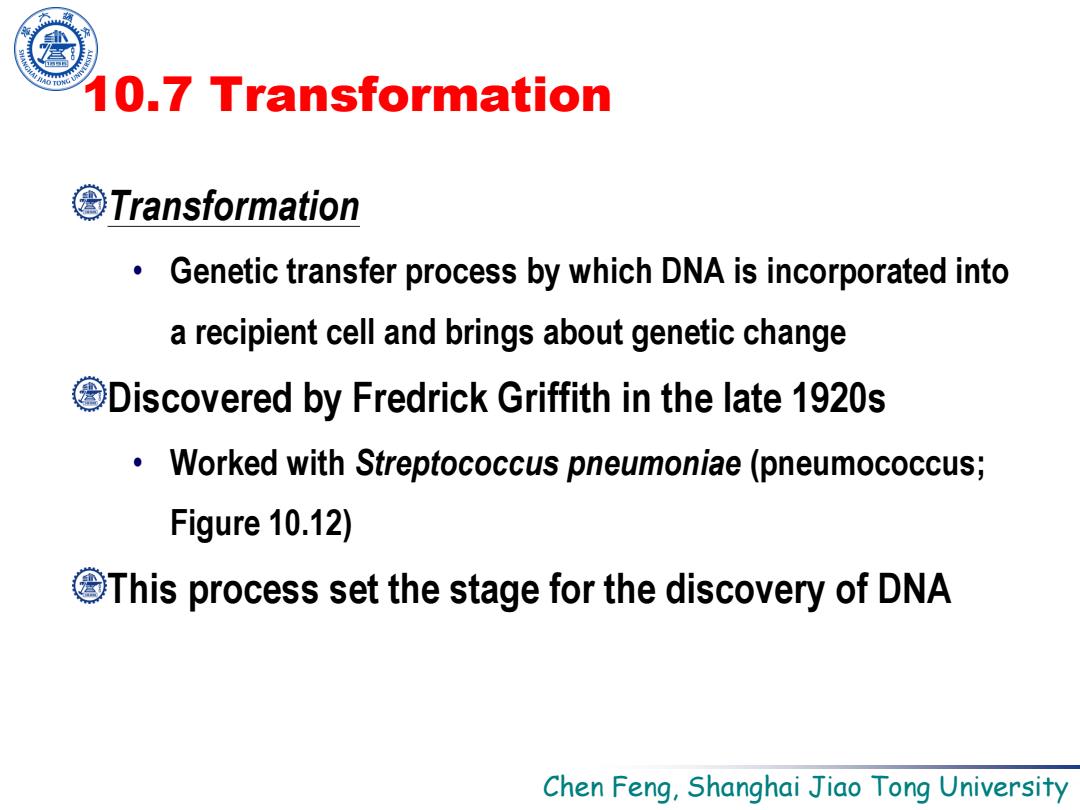
上泽充通大¥ Shanghai Jiao Tong University 1896 1920 1987 2006 How can a bacterium change itself by taking genes from other bacteria? Lecture 10-2 Bacterial genetics II.Genetic Exchange In Prokaryotes Chapter 1o in BROCK BIOLOGY OF MICROORGANISMS IJIAO TONG UN Chen Feng School of Life Science and Technology, Shanghai Jiao Tong University http://micro.sjtu.edu.cn
1896 1920 1987 2006 Lecture 10-2 Bacterial genetics II. Genetic Exchange In Prokaryotes How can a bacterium change itself by taking genes from other bacteria? Chen Feng School of Life Science and Technology, Shanghai Jiao Tong University http://micro.sjtu.edu.cn Chapter 10 in BROCK BIOLOGY OF MICROORGANISMS

10.6 Genetic recombination遗传重组 The physical exchange of genetic material between genetic elements Genetic elements: ·Chromosomes ·Plasmids ·Viruses Chen Feng,Shanghai Jiao Tong University
Chen Feng, Shanghai Jiao Tong University 10.6 Genetic recombination遗传重组 The physical exchange of genetic material between genetic elements Genetic elements: • Chromosomes • Plasmids • Viruses

Molecular Events in Homologous Recombination同源重组 General or homologous recombination同源重组 Genetic exchange between homologous DNA sequences from two different sources ©Homologous DNA sequences同源序列 Having the same or nearly the same sequence Extremely important for all organisms重要性 .25 genes involved in E.coli Several redundant pathways.Therefore,if one pathway is inhibited,.another may supply necessary functions..有数条替代 途径备用 Chen Feng,Shanghai Jiao Tong University
Chen Feng, Shanghai Jiao Tong University Molecular Events in Homologous Recombination 同源重组 General or homologous recombination同源重组 • Genetic exchange between homologous DNA sequences from two different sources Homologous DNA sequences同源序列 • Having the same or nearly the same sequence Extremely important for all organisms重要性 • 25 genes involved in E. coli • Several redundant pathways. Therefore, if one pathway is inhibited, another may supply necessary functions.有数条替代 途径备用

Donor DNA Endonuclease nicks DNA Molecular mechanism of genetic recombination Nick 0 Binding of SSB protein SSB protein Processes: 00000 Recipient DNA 1.Nick formation Strand RecA invasion 2.Strand invasion protein 000 3.Heteroduplex formation 源双链核酸的形成 Development of cross-strand exchange 4.Resolution of heteroduplex complex (SSB)single-stranded binding protein Resolution Resolution at sites at Vsites Patches Splices 2012 Pearson Education,Inc
Molecular mechanism of genetic recombination Processes: 1. Nick formation 2. Strand invasion 3. Heteroduplex formation异 源双链核酸的形成 4. Resolution of heteroduplex complex (SSB) single-stranded binding protein

Detection of recombination DNA from Trp*cells Agar lacking Agar lacking tryptophan tryptophan Trp-cells No growth Trpcells Recombinants form colonies A selective medium can be used to detect rare genetic recombinants among a large population of nonrecombinants.On the selective medium only the rare recombinants form colonies
Chen Feng, Shanghai Jiao Tong University Detection of recombination A selective medium can be used to detect rare genetic recombinants among a large population of nonrecombinants.On the selective medium only the rare recombinants form colonies

Processes leading to genetic recombination in prokaryotic cells原核生物遗传重组的类型 Transformation转化 Donor DNA is free in the environment Transduction转导 Donor DNA is transferred by a virus @Conjugation接合 Donor DNA is transferred via cell-to-cell contact and a conjugative plasmid Horizontal gene transfer Chen Feng,Shanghai Jiao Tong University
Chen Feng, Shanghai Jiao Tong University Processes leading to genetic recombination in prokaryotic cells 原核生物遗传重组的类型 Transformation 转化 • Donor DNA is free in the environment Transduction 转导 • Donor DNA is transferred by a virus Conjugation 接合 • Donor DNA is transferred via cell-to-cell contact and a conjugative plasmid Horizontal gene transfer

@Transformation转化 Donor DNA is free in the environment @Transduction转导 -Donor DNA is transferred by a virus ©Conjugation接合 Donor DNA is transferred via Donor Donor cell-to-cell contact and a Virus injection, conjugative plasmid chromosome disruption Plasmid-containing Donor cell with donor cell integrated plasmid Recipient Donor cells- DNA- Free DNA containing Conjugation: viruses Conjugation: Plasmid Chromosome transfer transfer Recipient Recipient Transformation Transduction Figure 10-11 part 1 Brock Biology of Microorganisms 11/e 2006 Pearson Prentice Hall,Inc
Transformation 转化 Donor DNA is free in the environment Transduction 转导 Donor DNA is transferred by a virus Conjugation 接合 Donor DNA is transferred via cell-to-cell contact and a conjugative plasmid

10.7 Transformation Transformation Genetic transfer process by which DNA is incorporated into a recipient cell and brings about genetic change Discovered by Fredrick Griffith in the late 1920s Worked with Streptococcus pneumoniae(pneumococcus; Figure 10.12) This process set the stage for the discovery of DNA Chen Feng,Shanghai Jiao Tong University
Chen Feng, Shanghai Jiao Tong University 10.7 Transformation Transformation • Genetic transfer process by which DNA is incorporated into a recipient cell and brings about genetic change Discovered by Fredrick Griffith in the late 1920s • Worked with Streptococcus pneumoniae (pneumococcus; Figure 10.12) This process set the stage for the discovery of DNA

Live Heat-killed Live Live R cells Live S cells S cells R cells heat-killed S cells S cells 2012 Pearson Education,Inc Griffith's experiments with pneumococcus. Live smooth(S)cells contain a capsule and kill mice. Rough(R)cells have no capsule and are not pathogenic. But a combination of live R and dead S cells kill mice,and live S type cells can be isolated from the animals
Griffith's experiments with pneumococcus. • Live smooth (S) cells contain a capsule and kill mice. • Rough (R) cells have no capsule and are not pathogenic. • But a combination of live R and dead S cells kill mice, and live S type cells can be isolated from the animals

10.7 Transformation Competent:cells capable of taking up DNA and being transformed感受态 In naturally transformable bacteria,competence is regulated In other strains,specific procedures are necessary to make cells competent Electricity can be used to force cells to take up dNA (electroporation) Chen Feng,Shanghai Jiao Tong University
Chen Feng, Shanghai Jiao Tong University 10.7 Transformation Competent: cells capable of taking up DNA and being transformed感受态 • In naturally transformable bacteria, competence is regulated • In other strains, specific procedures are necessary to make cells competent • Electricity can be used to force cells to take up DNA (electroporation)